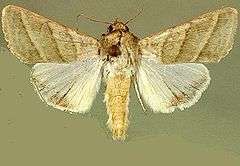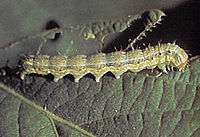Heliothis
Heliothis is a genus of moths in the family Noctuidae. It was first described by Ferdinand Ochsenheimer in 1816. Some of the species have larvae which are agricultural pests on crop species such as tobacco, cotton, soybean and pigeon pea. Some species originally in this genus have been moved to other genera, see Chloridea and Helicoverpa.
| Heliothis | |
|---|---|
 | |
| Heliothis virescens | |
| Scientific classification | |
| Kingdom: | |
| Phylum: | |
| Class: | |
| Order: | |
| Family: | |
| Subfamily: | |
| Genus: | Heliothis Ochsenheimer, 1816 |
| Subgenera | |
| Synonyms | |
| |
Taxonomy
Several species of moths of agricultural importance that used to be placed in this genus now are classified as members of the genus Helicoverpa, such as the corn earworm, Helicoverpa zea.[1]
Description
The proboscis is fully developed. Palpi porrect (extending forward) and second joint evenly clothed with long hair. The third joint is short and depressed and a short frontal shift. Thorax and abdomen without tufts. Fore tibia has a pair of slender terminal spines, whereas mid and hind tibia also spined. Forewings with veins 8 and 9 sometimes given off from the end of the areole.[2]
Species
- Subgenus Heliothis:
- Heliothis acesias Felder & Rogenhofer, 1872
- Heliothis australis Hardwick, 1994
- Heliothis belladonna (H. Edwards, 1881)
- Heliohis borealis (Hampson, 1903)
- Heliothis conifera (Hampson, 1913)
- Heliothis cystiphora (Wallengren, 1860)
- Heliothis flavescens (Janse, 1917)
- Heliothis flavigera (Hampson, 1907)
- Heliothis fuscimacula (Janse, 1917)
- Heliothis hoarei Matthews, 1999
- Heliothis lucilinea Walker, 1858
- Heliothis maritima Graslin, 1855
- Heliothis metachrisea (Hampson, 1903)
- Heliothis melanoleuca Mitchell, 1997
- Heliothis molochitina (Berg, 1882)
- Heliothis nubigera Herrich-Schäffer, [1851]
- Heliothis ononis (Denis & Schiffermüller, 1775)
- Heliothis oregonica (H. Edwards, 1875)
- Heliothis pauliani Viette, 1959
- Heliothis peltigera (Denis & Schiffermüller, 1775)
- Heliothis perstriata (Brandt, 1941)
- Heliothis philbyi (Brandt, 1941)
- Heliothis phloxiphaga Grote & Robinson, 1867
- Heliothis proruptus Grote, 1873
- Heliothis punctifera Walker, 1857
- Heliothis roseivena (Walker, 1866)
- Heliothis scutuligera Guenée, 1852
- Heliothis sturmhoefeli Draudt, 1927
- Heliothis subflexa (Guenée, 1852)
- Heliothis tergemina (C. Felder & Rogenhofer, 1874)
- Heliothis virescens (Fabricius, 1777)
- Heliothis viriplaca (Hufnagel, 1766)
- Heliothis xanthia Angulo y Olivares, 1999
- Heliothis xanthiata Walker, 1865
- Subgenus Masalia:
- Heliothis albida (Hampson, 1905)
- Heliothis albipuncta (Hampson, 1910)
- Heliothis cruentata (Moore, 1881)
- Heliothis decorata (Moore, 1881)
- Heliothis disticta (Hampson, 1902)
- Heliothis galatheae (Wallengren, 1856)
- Heliothis leucosticta (Hampson, 1902)
- Heliothis nubila (Hampson, 1903)
- Heliothis philbyi (Brandt, 1941)
- Heliothis perstriata (Brandt, 1941)
- Heliothis quilengesi Seymour, 1972
- Heliothis sublimis (Berio, 1962)
- Heliothis transvaalica (Distant, 1902)
- Heliothis uncta (Swinhoe, 1885)
- Subgenus Timora (also treated as a separate genus):
- See: Timora
References
- Kingan, Timothy G.; Thomas-Laemont, Patricia A. & Raina, Ashok K. "Male accessory gland factors elicit change from 'virgin' to 'mated' behaviour in the female corn earworm moth Helicoverpa zea". Journal of Experimental Biology 183.1 (1993): 61-76.
- Hampson, G. F. (1894). The Fauna of British India, Including Ceylon and Burma: Moths Volume II. Taylor and Francis – via Biodiversity Heritage Library.

External links
- H. virescens, tobacco budworm on the UF / IFAS Featured Creatures Web site
- Savela, Markku. "Heliothis Ochsenheimer, 1816". Lepidoptera and Some Other Life Forms. Retrieved January 16, 2019.

